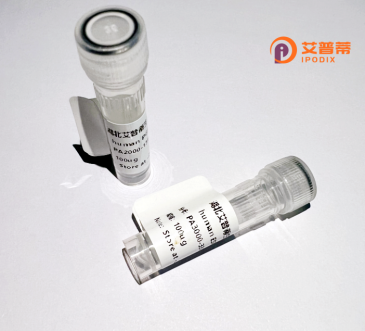
| 纯度 | >90%SDS-PAGE. |
| 种属 | Human |
| 靶点 | ARL8A |
| Uniprot No | Q96BM9 |
| 内毒素 | < 0.01EU/μg |
| 表达宿主 | E.coli |
| 表达区间 | 1-186aa |
| 氨基酸序列 | MIALFNKLLD WFKALFWKEE MELTLVGLQY SGKTTFVNVI ASGQFNEDMI PTVGFNMRKI TKGNVTIKLW DIGGQPRFRS MWERYCRGVS AIVYMVDAAD QEKIEASKNE LHNLLDKPQL QGIPVLVLGN KRDLPGALDE KELIEKMNLS AIQDREICCY SISCKEKDNI DITLQWLIQH SKSRRS |
| 分子量 | 46.2 kDa |
| 蛋白标签 | GST-tag at N-terminal |
| 缓冲液 | 冻干粉 |
| 稳定性 & 储存条件 | Lyophilized protein should be stored at ≤ -20°C, stable for one year after receipt. Reconstituted protein solution can be stored at 2-8°C for 2-7 days. Aliquots of reconstituted samples are stable at ≤ -20°C for 3 months. |
| 复溶 | Always centrifuge tubes before opening.Do not mix by vortex or pipetting. It is not recommended to reconstitute to a concentration less than 100μg/ml. Dissolve the lyophilized protein in distilled water. Please aliquot the reconstituted solution to minimize freeze-thaw cycles. |
以下是关于ARL8A的3篇代表性文献的简要总结:
1. **文献名称**:**"ARL8A is required for lysosomal targeting of mTORC1 and nutrient sensing"**
- **作者**:Gillingham AK, et al.
- **摘要**:该研究揭示了ARL8A通过与溶酶体定位复合体HOPS相互作用,调控mTORC1信号通路向溶酶体的靶向转运,影响细胞对营养状态的感知和代谢调控。
2. **文献名称**:**"ARL8A controls autophagosome elongation by regulating ATG9A trafficking"**
- **作者**:Khatter D, et al.
- **摘要**:研究发现ARL8A通过协调自噬相关蛋白ATG9A的囊泡运输,促进自噬体膜的延伸和成熟,强调了其在自噬过程中的关键作用。
3. **文献名称**:**"ARL8A/B/KIF5B axis drives neuronal lysosome trafficking and function"**
- **作者**:Farias GG, et al.
- **摘要**:文章阐明ARL8A与动力蛋白KIF5B结合,驱动溶酶体沿微管向神经元轴突远端运输,维持神经细胞中溶酶体的功能性分布及其降解能力。
4. **文献名称**:**"Targeting ARL8A suppresses tumor progression by disrupting lysosome function"**
- **作者**:Li X, et al.
- **摘要**:研究提出ARL8A在癌症中高表达,干扰其功能可破坏溶酶体酸化和降解能力,抑制肿瘤细胞的增殖和转移,提示其作为潜在治疗靶点。
每篇文献均聚焦于ARL8A在膜运输、溶酶体功能或疾病中的分子机制。如需具体年份或期刊信息,可进一步补充。
**Background of Recombinant ADP-Ribosylation Factor-Like Protein 8A (ARL8A)**
ARL8A, a member of the ADP-ribosylation factor-like (ARL) protein family, is a small GTPase involved in intracellular trafficking and membrane dynamics regulation. It cycles between GTP-bound (active) and GDP-bound (inactive) states, a mechanism critical for its regulatory role in vesicle transport, lysosomal positioning, and autophagy. ARL8A is ubiquitously expressed, with prominent roles in neuronal and immune cells due to its influence on lysosome-related functions.
Structurally, ARL8A shares conserved GTPase domains with other ARL proteins but exhibits unique effector-binding regions that enable specific interactions. It regulates lysosomal motility by linking lysosomes to microtubule-based motor proteins, such as kinesins, facilitating their anterograde movement toward the cell periphery. This process is vital for lysosomal nutrient sensing, degradation, and antigen presentation.
ARL8A also interacts with HOPS complex proteins and Rab7. coordinating late endosomal-lysosomal fusion. Dysregulation of ARL8A is linked to neurodegenerative diseases (e.g., Alzheimer’s) and cancers, where altered lysosomal activity promotes tumor invasiveness or impairs cellular clearance. Recombinant ARL8A is widely used in studies exploring lysosomal biology, membrane trafficking mechanisms, and therapeutic targeting of lysosome-associated disorders. Its conserved function across species and central role in cellular homeostasis underscore its significance in fundamental and biomedical research.
×